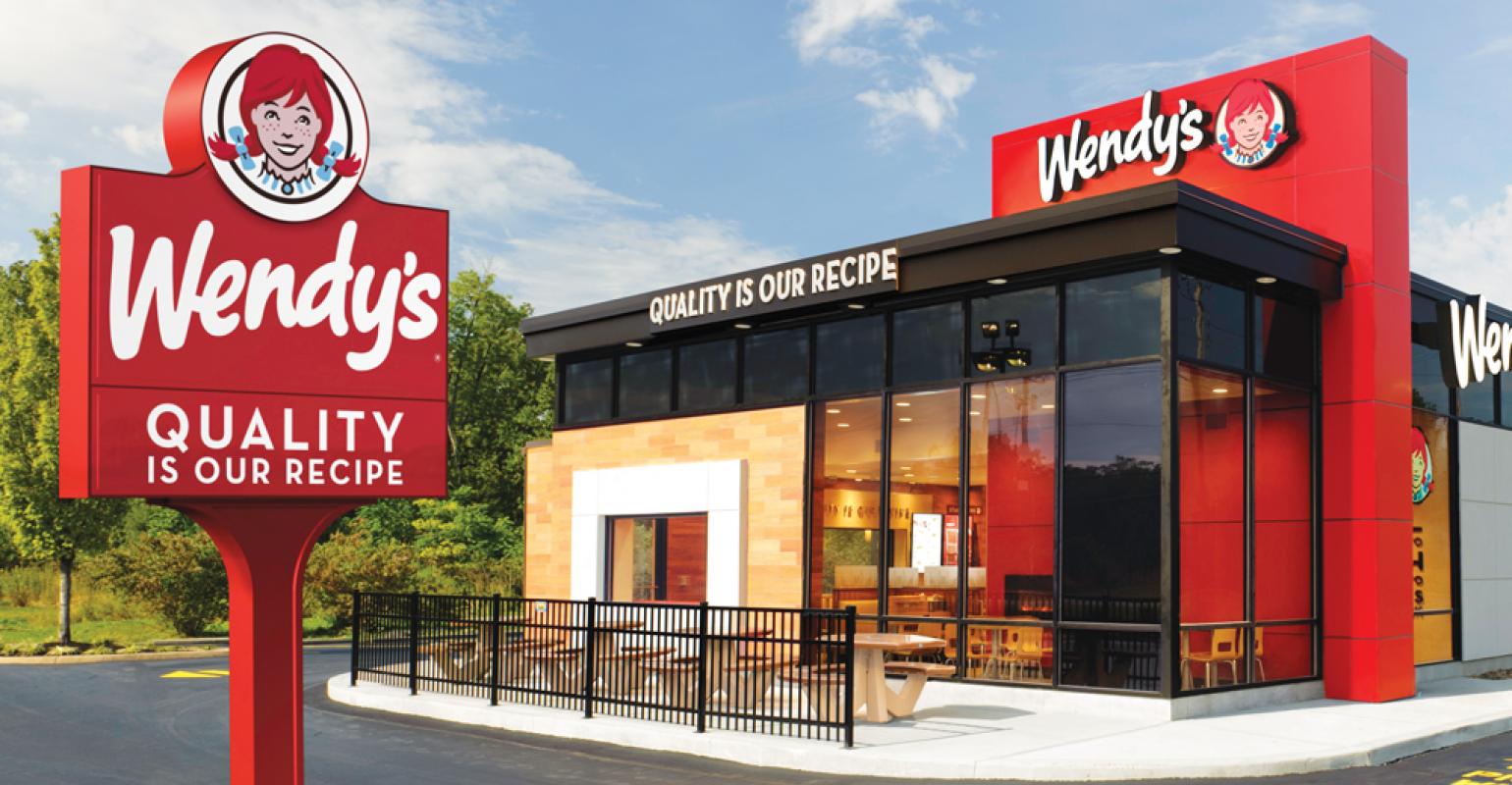The first Wendy’s restaurant was started in 1969, in Columbus, Ohio. By the 1980s, it had become the nation’s third-largest hamburger restaurant chain, following only McDonald’s and Burger King. The founder of the company was Dave Thomas, who would become as well known as a philanthropist as he was as a businessman. Thomas got his start in the restaurant business with Kentucky Fried Chicken (KFC), but left to pursue his childhood dream of operating a hamburger restaurant. Not finding a hamburger restaurant in Columbus to his liking, he opened one himself, which he named “Wendy’s,” after his then two-year-old daughter, Melinda Sue, whose nickname was Wendy.
Thomas’s formula for success was simple. It became known as his “mop bucket” approach to management. “You can’t have a clean floor with a dirty mop bucket,” he said. “To be successful, you need to take care of the basics of your business – and that means making sure you don’t overlook the little details.”
From the start, Wendy’s emphasized freshness. A 1974 ad stated, “We make our hamburgers fresh every day;” and, in a 1980 ad, “You want heat lamps? Go to a health spa.” In 1984, the company’s advertising slogan, “where’s the beef,” became something of a national craze, gaining the company enormous free publicity.
Today, Wendy’s fast food restaurant is one of the most important franchises in the United States and aboard. Its list of top game elements into account options: burgers, cheeseburger and fries, hamburger, Beverage includes frosty. are so well known for one of its current dessert: apple pie and breakfast sandwich: egg muffin.
Wendy has almost 6,500 restaurants in different countries, following by Mcdonalds’s 38,000 and Burger king’s 12,300 restaurants in different countries. Over 75 % of international restaurants Wendy operates to remain active and independent owners.
History
In 1982, while the company was doing well, and as a new management team sought to introduce innovations to the company such as a salad bar, Dave Thomas stepped down as president and assumed the title of “senior chairman.”
By the late 1980s, some problems surfaced. An attempt to introduce an upscale breakfast menu proved to be a failure, and the company suffered two years of decline in same-store sales. In 1988, the company launched its “Hamburger A” spoof ad, in which various consumers, in a side by side test, actually pick Hamburger B, a dry, tasteless hamburger, over Hamburger A, a tasty Wendy’s hamburger.
The turnaround of the business was short-lived; however, and the company soon embarked on a new tact, one that involved the return of R. David Thomas (as he was known prior to his re-imaging
during the 1990s) to active participation in the company. At about this time, Robert L. Barney, the company’s chairman of the board, who had been the firm’s longtime president, retired; and, the position of his successor as president and CEO, Jim Near, strengthened.
Leading from the front – Dave Thomas story
During the 1990s, Dave Thomas appeared in more commercials than anyone else ever had, and became one of the most well-known people in the country. These commercials became one of the great success stories of the decade. However, it didn’t quite start out that way. Thomas was initially reluctant to appear in the commercials, and he did not come across well in the first spot.
But, by working at it, Thomas mastered the image of a decent, hardworking businessman obsessed with the idea of selling a fresh, good-tasting hamburger. At the meeting of the company’s key executives and their ad agency in New York City, where this advertising concept was developed, Thomas said, “Basically, … I want to go to basics in our advertising. We need to go back to talking about the thing that made us great: our old-fashioned hamburgers.” The head of the agency replied, “What we need is someone credible to give out that message, and I don’t think there’s anyone better to do that job
than you.”
By 1991, Wendy’s “back to basics” strategy had returned the company to its mid-1980s form (“Wendy’s; and, by 1992, the company reclaimed the #3 spot in the industry, which had briefly been captured by Hardee’s.
The initial years of Wendy’s
By the late 1990s, the company had 5,200 hamburger restaurants, 1,200 of which were company-owned and 4,000 franchisees. In addition, the company had a position in a related business with 1,500 Tim Horton Coffee & Donut stand in Canada. But, with slackening sales growth and slipping profit margins, in 1998, the company dropped the salad bar it had introduced during the 1980s and took $73 million in restructuring losses, even as it planned to open a total of 575 new Wendy’s and Tim Hortons units during the forthcoming year.
In 1995, Gordon F. Teter succeeded to the office of chairman, president, and CEO of the company, having been the president and COO since 1991, upon the sudden death of Jim Near – at the age of 58 – of a heart attack. In 1999, at the age of 67, Dave Thomas was suddenly recalled to duty as chairman and CEO, when Teter – at the age of 56 – also died suddenly of a heart attack.
Joining Thomas in the management team was John “Jack” Schuessler as president and COO. Within a year, Shuessler was named chairman and CEO, and Thomas reverted to his status of the senior chairman. A couple of years later, Dave Thomas passed away.
Wendy’s made several strategic moves during the tenure of Jack Schuessler, who was not optimistic about the growth prospects for fast-food restaurants. In 2002, Wendy’s acquired Baja Fresh Mexican Grill, a 169-unit chain, in an all-cash, $275 million deal. In two steps, starting in 2002, the company acquired a 70 percent stake in Café Express, with 18 restaurants in Houston and Dallas, Texas, for a total of $14 million. Also in two steps, starting in 2002, the company acquired a minority stake in Pasta Pomodoro, a 44-unit chain of Italian restaurants.
Together with the company’s original hamburger restaurants and its Tim Hortons Coffee stands, the corporation had accumulated a diverse set of restaurant businesses. It was during this period that the company’s Wendy’s hamburger restaurants extended their hours to include late-night business, and began wide-spread acceptance of credit cards.
Present Scenario
The company is known for high-quality products. Quality is emphasized in Wendy’s mission and vision statements. For example, the square-shaped hamburger patties are marketed as freshly prepared beef. In addition, Wendy’s has developed into an effective business because of its experience since it was founded in 1969. Also, as one of the top players in the global fast-food restaurant market, the company has one of the strongest competing brands.
But there are certain challenges. Most of Wendy’s revenues are generated in North America. The company’s financial reports indicate that its revenues from other regions are “immaterial.” This condition prevents Wendy’s from maximizing its performance in the global market. Also, the company has limited diversification, which is reflected in the lack of major product or business innovation. Another weakness is that many of Wendy’s products are imitable. Smaller firms, especially in developing countries, can copy Wendy’s products.
Hence, it has the opportunity to expand internationally. Global expansion can increase the company’s market reach and boost its finances. Wendy’s also has the opportunity to diversify its business. For example, the company can acquire complementary businesses in the foodservice industry, or develop an entirely new line of products. In relation, Wendy’s can innovate more aggressively to increase its competitiveness against firms like McDonald’s and Burger King.
Aggressive competitors threaten Wendy’s business. For example, McDonald’s is aggressive in marketing and global expansion. Also, imitation is a threat that could reduce the competence and attractiveness of Wendy’s products. Moreover, an increasing level of health-consciousness could reduce or dampen demand for products from firms like Wendy’s.
Also Read: KFC – It’s Not Good, It’s Finger Lickin’ Good
Social Media is Lit!
Social Media Marketing: They’ve hit the trifecta of humor, brand awareness, and authenticity. For years, Wendy’s had this quirky and out-of-the-box way to drive interactions on social media. We know the end goal was to sell burgers, but the tweets were so funny and good, most people didn’t even care.
Simply put, Wendy’s wasn’t afraid to drop the mic. The brand — represented by a sweet-faced, red-haired girl — roasted fans, cracked jokes and called out competitors. She also promoted her menu, gave away free food, and even dabbled in the occasional rap battle.
Its funny persona led to Wendy’s snagging the #1 spot on Fast Company’s Most Innovative Companies list of 2019 in the category of Social Media. Wendy’s tweets were engaging, highly clever, and at times, laugh-out-loud funny.
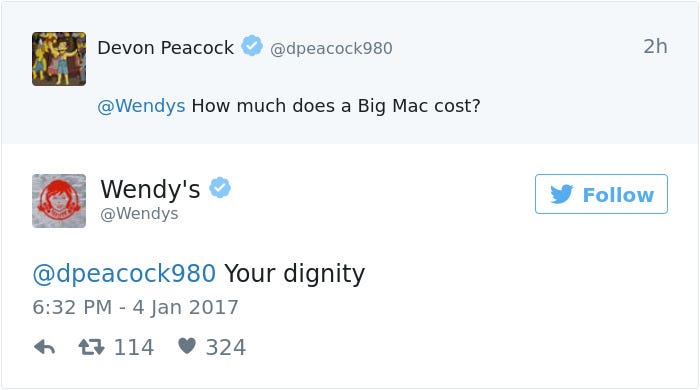
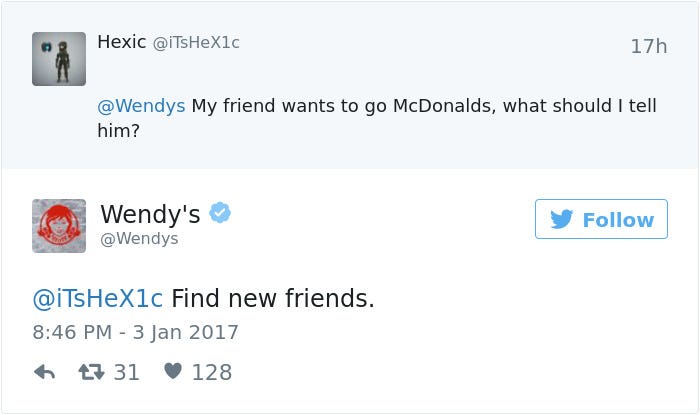
By the way, remember when some guy online won a years’ worth of free nuggets after he tweeted to Wendy’s? Carter Wilkerson asked Wendy’s for some free nuggs, which resulted in him becoming the author of the most-retweeted tweet in Twitter’s history. His quest for chicken nuggets, #NuggsforCarter, got retweeted a staggering 3.4 million times!
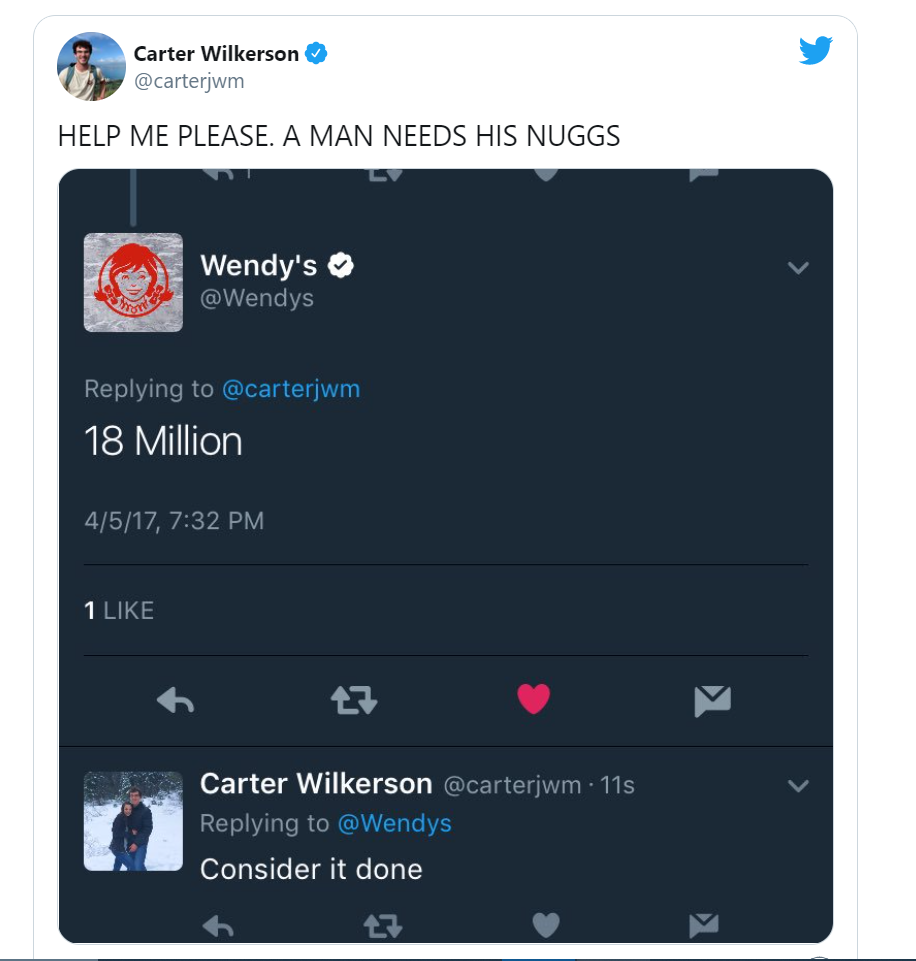
They’re playful: Wendy’s manages to be self-promoting and fun. Their brand voice is clever, casual and funny, and sets them apart from the competition. This isn’t their first, or last, jab at McDonald’s. In their 2018 Super Bowl ad “Iceberg”, they used a copy from McDonald’s website against them (“our beef is flash-frozen to seal in fresh flavor”) and urged consumers to “skip the hamburgers at the Frozen Arches”.
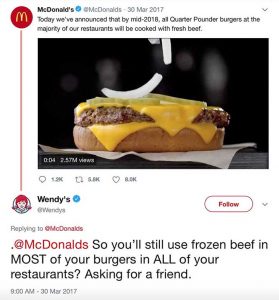
They’re responsive! Due to the internet, customers today are used to constant and instant accessibility, and Wendy’s is extremely responsive. Wendy’s responds quickly, and seriously, to customers who have complaints, and will even apologize for the delay if it takes them a while to respond.
They’re consistent. Wendy’s posts frequently, and maintain the same voice throughout their postings. Consistency is key on social media, both in terms of what you’re posting and how often. Even when they are posting different types of content, their voice is consistent, and in line with the brand as a whole. The long-term consistency allows them to keep their audience engaged, and the momentum going.

To read more content like this, subscribe to our newsletter.
